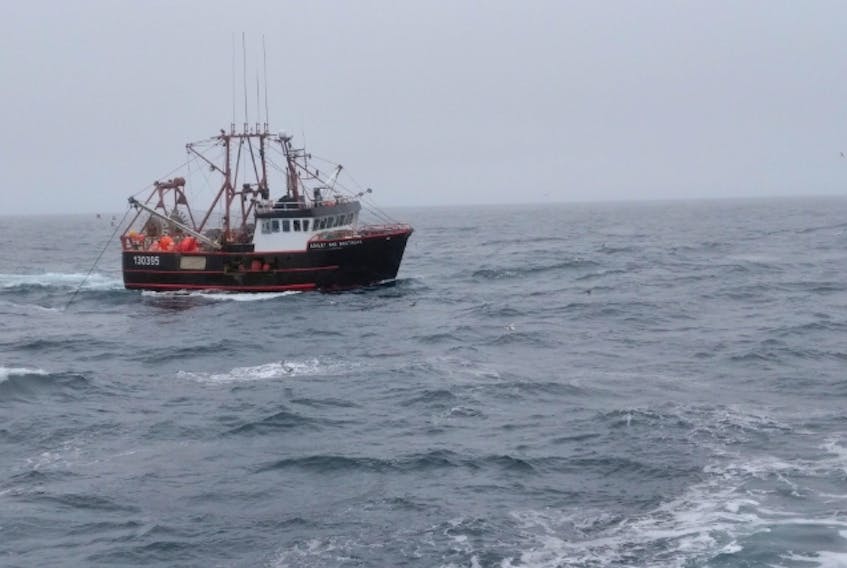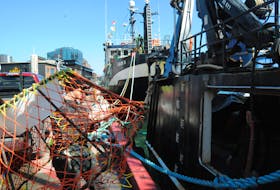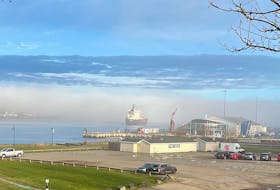Roland Genge is not certain that he will be fishing shrimp this year.
The owner of the Newfie Pride had hoped to be untying his longliner from the wharf at Anchor Point this week, to head to the shrimp fishing grounds in fishing region 4R.
He had hoped to be able to have good catches to provide a good summer’s wages for his crew — his 31-year-old son Travis among them.
Instead, he’s wondering if he will land any shrimp at all, and whether his son will have any luck getting a berth fishing on an offshore factory trawler to make a living.
Normally, the shrimp fishing season starts by June, with fishers in this area wrapping up their season in late August and hoping not to have to fish through the bad weather months of mid to late fall.
But a wrangle over shrimp prices has lasted longer than usual, thanks in part to the uncertain markets caused by COVID-19.
In mid June the province’s Price Setting Panel decided on a price of $1.18 per pound, choosing the price suggested by the Fish Food and Allied Workers (FFAW-Unifor) over the price of 70 cents suggested by the Association of Seafood Processors (ASP).
The price dropped again last week, to $1.08 a pound, after the ASP request a price review by the panel.
Then, in a press release on Monday, the FFAW alleged the “majority of processors have refused to buy at the negotiated price.”
Meanwhile, according to the union, shrimp processors in New Brunswick and Quebec, including a Royal Greenland-owned plant, have been buying shrimp from harvesters in that province while refusing to purchase from Newfoundland and Labrador harvesters.
The union press release came the day shrimp harvesters from 4R met at Anchor Point to decide whether they would fish at a price below the negotiated price of $1.08 per pound.
They decided they would not.
The following day the ASP issued its own press release.

Derek Butler, executive director of ASP, said shrimp was in trouble with high global inventories and falling markets before Covid-19, which added to the market challenges.
He said prices set in arbitration are simply not economical, and producers risk undermining their entire operations if they run at such high losses.
“It is a very difficult decision, and we knew that going into it, that is why the parties postponed negotiations from April to the end of June, it’s why we gave up on a spring and early summer fishery.”
Butler added, "Shrimp produces are exploring every possible avenue to ensure a fishery.”
With the uncertainty comes frustration and worry, not only for fishing captains and crew members, but for the people who are hoping for work at shrimp plants in Anchor Point and Port au Choix this season.
Rendell Genge of Anchor Point is chair of the 4R Shrimp fleet.
There are about 45 boats in the 4R fleet, he told Saltwire, and many of them operate with crews of five or six.
Each of those crew members has been biding time, waiting for word for the start of the shrimp season, anxious to set sail.
On Rendell’s boat the crew includes two grandsons in their early 20s. They’re studying at the Marine Institute and were depending on the fishing season for a chance to earn some money for college.
His other crew member are in their 40s, he said, with bills to pay and families to feed.
“It is a very difficult decision, and we knew that going into it, that is why the parties postponed negotiations from April to the end of June, it’s why we gave up on a spring and early summer fishery.”
While they qualify for the Canadian Emergency Response Benefit (CERB), Genge says that program is not the answer. Besides, it doesn’t offer the same level of income as they might make during a shrimping season, and the CERB is due to end in September.
“Crew members are calling us (harvesters) every day, asking if we’ve heard anything from the buyers,” said Rendell.
Roland Genge adds that at the current price of $1.08 per pound, most shrimp enterprises won’t make much profit, if any, this season.
But going fishing means putting people back to work, and helping out others beyond the fishing boat.
He thinks of the plant workers, and the potential spinoffs for the local economy.
“We’ve got three shrimp plants here and a fleet of boats. And all the spinoff jobs from that.
“Take that away from a rural area and it’s going to be pretty tough.”
He says leaders — local, provincial and federal — have to wake up and start thinking about the possibilities.
And he has a suggestion.
He points to the $146 million the federal government announced last week to help reboot the provincial economy.
“Why not put some of that money into this fishery,” he said, suggesting a subsidy on the price of shrimp to help make it feasible for processors to buy and harvesters to fish.
If a solution can’t be found, he said, then they might as well leave the shrimp in the water and play catch up next season.
“Leave that 10 million pounds out there to spawn and grow, and roll over this year’s quotas to next year,” he suggested.
Beyond the longliners in the 4R zone there are another 100 or so boats from other areas of the province that fish for shrimp in Shrimp Fishing Area (SFA) 6 in the 4R zone.
Many enterprise owners have invested heavily in this fishery, buying and refitting boats for shrimp fishing and borrowing to buy extra quotas under the federal government’s fleet rationalization program.
Yet cuts to shrimp quotas, and price drops, over the past several years have stripped away the seasonal value of the catch.
Rendell Genge notes he used to have a million pounds of shrimp to catch about 10 years ago. And even though the price of shrimp was about 40 cents a pound back then, the amount of quota made for a feasible enterprise.
The quotas have dropped to the point where, even though the price is more than a dollar a pound, the boat won’t make as much profit.
“Today, it’s not about making money. It’s about survival,” said Rendell.
Labrador shrimp fishers setting sail for Labrador Fishermens Shrimp Union company
While shrimp fishers from Newfoundland are in limbo, a dozen or more enterprises on the Labrador side of the Strait of Bell Isle are gearing up to set sail for the shrimp fishing grounds.
Shrimp fishers there sell to the Labrador Fishermen’s Union Shrimp Company, and that company is buying shrimp.
The company is also a member of ASP.
So why, you might wonder, would one member of ASP decide to buy at $1.08 per pound while others appear to be holding back?
Gilbert Linstead is the company manager.
He told SaltWire today, July 22, it wasn’t an easy or simple decision.
“There are still some risks on the marketing end,” he said. “It was a hard decision, and we took a little bit of time in making our decision. The board of directors eventually decided it was what we should do.
“It’s definitely a big risk for us. We’re going on a wing and a prayer and hoping it works out for all of us.”
Lindstead says the company still has some shrimp in storage from last season.
And they will have to store shrimp landed this season to await the best time to sell to market.
They sell mainly to the European market, he said, and the shrimp will be held in cold storage there awaiting sales.
While the members of the ASP operate collectively in price negotiations and other matters, Linstead said each member company decides for itself its operational plan for each season.
Most of the longliners will be heading out to sea this week, he said, and the company will start processing as soon as those catches are landed at the plant in Charlottetown, on the Labrador coast.
Still, he said, “It’s going to be quite a challenge and we’re looking at it with a bit of trepidation.”









